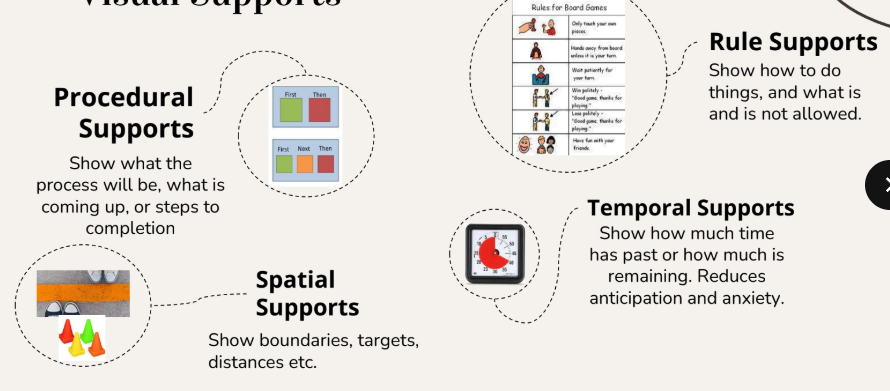communication and instructional strategies in APA 6
1/15
There's no tags or description
Looks like no tags are added yet.
Name | Mastery | Learn | Test | Matching | Spaced |
|---|
No study sessions yet.
16 Terms
what is expressive language
Putting words together
to cohesively express
thought - general
societal expectation to
be verbal.
communication is 50/50
miscommunication mainly happens when receivers dont recept in the way you want them to
what is receptive language
The comprehension of
language. Listening and
understanding with is
being communicated.
recieving info
what are the percents of human communication
7% verbal
38% paraverbal - our tone, cadence, volume, not what we say just how we say it, lost when we switched from email to text
55% nonverbal - body language, posture, personal space, motion of the body
what are the tips and tricks of verbal communication
Using spoken word to communicate
● Speak clearly and concisely
○ When necessary, limit cues to 3-4 words - when they have receptive delays
● Allow extra long processing time
● Use guided discovery questions
what is the guided discovery of verbal communication
Technique where the leader poses questions that have the group
explore answers on their own
● An “inductive” approach
● Students actively participate in acquiring knowledge.
● Fosters understanding of the “WHY”
Useful Question prompts:
What happens if...?
Should we try... or ...?
It is easier if...?
How could we...?
How does it feel when...?
what is nonverbal communication, kinescis, and proxemics
Our body language, posture,
and motion of the body

what is paraverbal communication
1) Tone
2) Volume
3) Cadence
how we say things
what are AAC’s
Alternative & Augmentative Communication
AAC’s include all forms of communication (other than oral speech) that are used to express thoughts, needs, wants, and ideas.
what is augmentive and alternative communication
aug - using facial expressions/body language to make a point or emphasize something
alt - using some kind of tool to communicate
what are some high tech options for communication
Electronic devices that permit the storage and retrieval
of messages, often providing speech output.
Can be speech generating devices (SGD’s) or Voice
Output Communication Aides (VOCA’s)
what are some low tech options for communication
Do not require batteries, electricity or
electronics to meet communication
needs
why do we use AAC’s for physical activity
● Increase understanding of activity requirements
● Facilitate communication
● Reduce unpredictability
● Help transition from one activity or environment to another
● Provide structure
● Increase understanding of social requirements
● Makes the ‘implicit’ more ‘explicit’ when necessary
how do we work with AAC users
● WAIT and give me a chance (a long one, a really long one) to respond
● MODEL verbs, adjectives, and fun things to say not just nouns and choices
● KNOW that I am learning every time you model for me, even if I seem
uninterested
● RESPECT that using my AAC device to speak is my choice and it shouldn’t
be forced
● UNDERSTAND that this device is my voice, and it should always be in my
reach – even if I’m choosing not to use it.
● RESPOND to everything the student says as if it is intentional
● DO NOT turn off the volume or take the device away
why should we use visuals
They reduce anxiety - Everyone likes to k what is coming next, how much longer it will be, and when the ‘fun’ and ‘hard’ parts occur
They reduce chances of miscommunication - A diagram, image, symbol etc can become easy and recognizable.
When provided with words, they match various learning and information processing styles - Some prefer photos. Some prefer words
what are visual supports

what are social stories
a social learning tool that supports the safe and meaningful
exchange of information